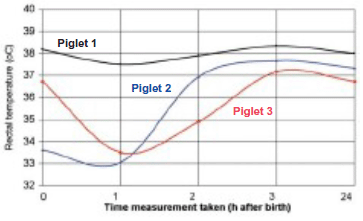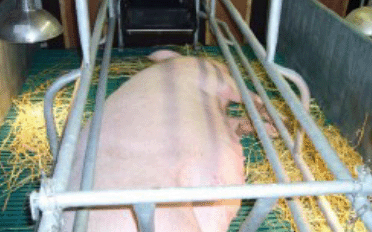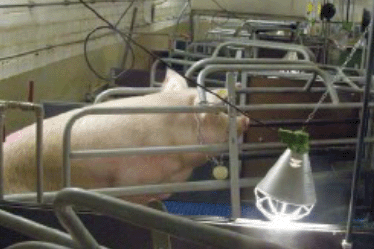



Farrowing House Management
The farrowing house is a key department in determining the productivity of a unit. Attention to detail at all times is vital for achieving the full potential of both piglets and sows, according to No. 38 in the 'Action for Productivity' series from BPEX.Targets
- Maximise neonatal piglet survival – aim for a pre-weaning mortality rate of 10.3 per cent* or better
- Produce healthy weaned piglets – aim to rear at least 11.2* piglets per litter
- Minimise loss of sow body condition – aim to maintain a body condition score (BCS) of 3.
* Based on Agrosoft data, September 2010, top third of UK indoor breeding herds
What Environment Does a Newly Born Piglet Require?
Newborn piglets are poorly equipped to keep warm immediately after birth, as they:
- are born wet
- have a large surface area to body mass
- have limited energy reserves (brown fat) to produce body heat and
- do not have hair to insulate them.
The critical factor which producers can control is limiting heat loss and facilitating a reversal and steady increase back to their normal body temperature.
Without a temperature rise, piglets will become lethargic, less competitive and more prone to starvation, disease and death.
It is important to provide an environment at farrowing that is dry, warm and draught-free. This can be achieved by:
- providing supplementary heat lamps during farrowing, one ideally positioned towards the rear of the pen
- providing bedding to reduce drafts from beneath the slats and to help dry the piglets at birth
- maintaining a farrowing house/room temperature of 22–24°C until the room has farrowed, providing this is completed within two to three days.
The importance of limiting heat loss

(Source: Dr E Baxter, SAC)
An important route for increasing piglets’ body temperature is through suckling. Sows must be calm and relaxed during farrowing and present their teats so that they are easily accessed by their piglets.
To provide an environment that will encourage this behaviour:
- Ensure that the sow or gilt is in the correct size crate so that she can lie comfortably
- Adjust the bottom rail where possible allowing her to expose both rows of teats
- Leave a radio on for background noise if some of the sows are anxious when hearing strange noises
- Assist the sow in expressing her normal nesting behaviour by providing bedding/paper bag or a piece of rope or toy attached to the farrowing crate. This behaviour relaxes the sow and makes her more likely to lie calmly and suckle her litter.

What Environment Promotes the Production of a Healthy Weaned Piglet?
This is where attention to detail is very important. The main objective is to minimise any illness in the piglets and then to prevent the transfer of disease to healthy piglets. Some of the management practices available to help create an environment in which piglets can thrive are to:

- Operate an all-in all-out system that facilitates thorough cleaning, disinfection and drying between each batch
- Keep separate equipment for each house and clean piglet equipment between litters
- Provide foot dips for each house and intra-house in cases of piglet scour outbreaks; ensure these are managed properly and used appropriately
- Maintain the integrity of the farrowing house flooring, repair cracks and remove any pooling of liquid through poor drainage or leaking pipes/troughs
- Replace old wooden pen divisions with robust, non-porous, easily cleaned and quick drying materials.

How Can Loss of Sow Body Condition be Minimised?
It is important to provide an environment that stimulates good Voluntary Feed Intake (VFI). In the farrowing house, it is necessary to provide two distinct environments, as shown in the table below.

The sow’s requirement for nutrients increases daily as her lactation progresses and demand for milk from the piglets increases. Her VFI, therefore, has to increase, otherwise she will start to mobilise her own reserves and lose body condition. Unfortunately, as the room temperature rises above 16°C, VFI will decline, initially at a rate of 170g/day per 1°C rise in temperature. The sow’s environment can be influenced by:
- Providing a covered creep which enables the farrowing room temperature to be run at 18-20°C
- Thermostatically controlling the temperature of the creep heat source and programming a temperature curve to reduce over time
- Regularly checking that heat mats, if used, are operating correctly
- Providing supplementary cooling, where possible, during hot periods
- Ensuring sows always have a plentiful supply of fresh, clean water; the flow rate should be 2 litres per minute for a nipple or bite drinker.
The aim should be for sows to lose no more than 0.5 in BCS throughout the lactation; this will increase the likelihood that she will successfully rebreed within six days post weaning.
June 2013








